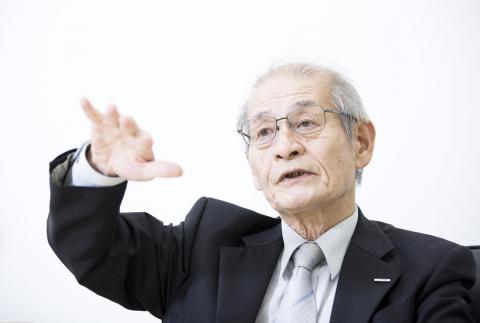Battery makers must rethink their technology if predictions for a wave of self-driving vehicles pan out, one of the inventors of the lithium-ion battery said.
Aside from focusing on making batteries more powerful to extend the driving range of single-owner cars, manufacturers will need to develop devices that can withstand the rigors of near-constant driving and short-range trips from the shared use expected of autonomous vehicles, said Akira Yoshino, who invented a prototype of the lithium-ion battery in 1985.
“A car shared by 10 people means it will be running 10 times more,” Yoshino, an honorary fellow at Asahi Kasei Corp., the world’s biggest maker of separators used in batteries, said in an interview at the company’s headquarters in Tokyo. “Durability will become very important.”

Photo: Bloomberg
While producers should still focus on improving energy density and lowering costs, they will also need to create batteries using materials that can better withstand constant expansion and contraction, Yoshino said.
The task becomes easier if there is less need to simultaneously boost energy density, which is the biggest factor for driving range, he said.
Lithium titanate, for example, can be used in the anode of the battery, where carbon is used commonly now.
“Cars are a completely new application, and we’ll have to wait until we find out what kind of batteries will really be needed,” Yoshino said. “The future of batteries depends on what will happen to the future of the automobile society.”
At Asahi Kasei’s laboratory in the early 1980s, Yoshino began researching polyacetylene, a conducting polymer discovered by the Japanese chemist and Nobel Prize winner Hideki Shirakawa. Although the material could be used in solar panels and semiconductors, Yoshino focused on batteries as a wave of small electronic devices requiring powerful, rechargeable energy sources began hitting the market.
He succeeded in building a lithium-ion battery using polyacetylene as the anode, later switching to carbon. However, Sony Corp beat Asahi Kasei in the race to commercialize it for mobile phones in 1991. The following year, Asahi Kasei formed a venture with Toshiba Corp to make and sell their own batteries.
“I thought it would be a boon to tap into the 8-millimeter video camera market,” Yoshino said, referring to an outdated format.
“Mobile phones, laptops and computers just kept multiplying, but no one was thinking about cars” at that time, he said.
That has since changed. Bloomberg New Energy Finance (BNEF) projects electric vehicles will account for 54 percent of new car sales by 2040. Highly autonomous cars are expected in about 2020, but technical and legal challenges to mass-market use of fully autonomous cars will not be solved before 2030, BNEF said in a Dec. 1 report.
Yoshino was a recipient with three others of the 2014 Charles Stark Draper Prize for engineering for their contribution to the development of the lithium-ion battery.

SEEKING CLARITY: Washington should not adopt measures that create uncertainties for ‘existing semiconductor investments,’ TSMC said referring to its US$165 billion in the US Taiwan Semiconductor Manufacturing Co (TSMC, 台積電) told the US that any future tariffs on Taiwanese semiconductors could reduce demand for chips and derail its pledge to increase its investment in Arizona. “New import restrictions could jeopardize current US leadership in the competitive technology industry and create uncertainties for many committed semiconductor capital projects in the US, including TSMC Arizona’s significant investment plan in Phoenix,” the chipmaker wrote in a letter to the US Department of Commerce. TSMC issued the warning in response to a solicitation for comments by the department on a possible tariff on semiconductor imports by US President Donald Trump’s

The government has launched a three-pronged strategy to attract local and international talent, aiming to position Taiwan as a new global hub following Nvidia Corp’s announcement that it has chosen Taipei as the site of its Taiwan headquarters. Nvidia cofounder and CEO Jensen Huang (黃仁勳) on Monday last week announced during his keynote speech at the Computex trade show in Taipei that the Nvidia Constellation, the company’s planned Taiwan headquarters, would be located in the Beitou-Shilin Technology Park (北投士林科技園區) in Taipei. Huang’s decision to establish a base in Taiwan is “primarily due to Taiwan’s talent pool and its strength in the semiconductor

An earnings report from semiconductor giant and artificial intelligence (AI) bellwether Nvidia Corp takes center stage for Wall Street this week, as stocks hit a speed bump of worries over US federal deficits driving up Treasury yields. US equities pulled back last week after a torrid rally, as investors turned their attention to tax and spending legislation poised to swell the US government’s US$36 trillion in debt. Long-dated US Treasury yields rose amid the fiscal worries, with the 30-year yield topping 5 percent and hitting its highest level since late 2023. Stocks were dealt another blow on Friday when US President Donald

UNCERTAINTY: Investors remain worried that trade negotiations with Washington could go poorly, given Trump’s inconsistency on tariffs in his second term, experts said The consumer confidence index this month fell for a ninth consecutive month to its lowest level in 13 months, as global trade uncertainties and tariff risks cloud Taiwan’s economic outlook, a survey released yesterday by National Central University found. The biggest decline came from the timing for stock investments, which plunged 11.82 points to 26.82, underscoring bleak investor confidence, it said. “Although the TAIEX reclaimed the 21,000-point mark after the US and China agreed to bury the hatchet for 90 days, investors remain worried that the situation would turn sour later,” said Dachrahn Wu (吳大任), director of the university’s Research Center for